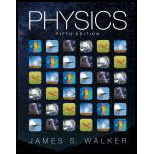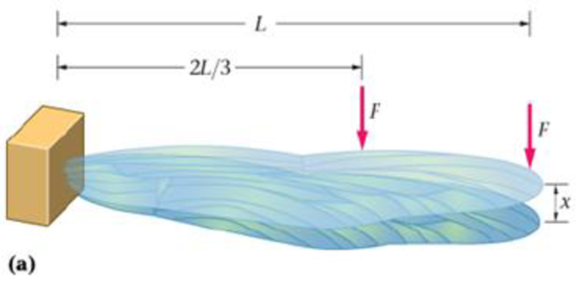
BIO The Flight of the Dragonflies
Of all the animals you’re likely to see on a summer day, the most ancient is the dragonfly. In fact, the fossil record for dragonflies extends back over 250 million years, more than twice as long as for birds. Ancient dragonflies could be as large as a hawk, and were surely buzzing around the heads of both T. Rex and Triceratops.
Dragonflies belong to the order Odonata (“toothed jaws”) and the suborder Anisoptera (“different wings”), a reference to the fact that their hindwings are wider front-to-back than their forewings. (Damselflies. in contrast, have forewings and hindwings that are the same width ) Although ancient in their lineage, dragonflies are among the fastest flying and most acrobatic of all insects; some of their maneuvers subject them to accelerations as great as 20g.
The properties of dragonfly wings, and how they account for such speed and mobility, have been of great interest to biologists Figure 8-47 (a) shows an experimental setup designed to measure the force constant of Plexiglas models of wings, which are used in wind tunnel tests A downward force is applied to the model wing at the tip (1 for hindwing, 2 for forewing) or at two-thirds the distance to the tip (3 for hindwing, 4 for forewing). As the force is varied in magnitude, the resulting deflection of the wing is measured The results are shown in Figure 8-47 (b) Notice that significant differences are seen between the hindwings and forewings, as one might expect from their different shapes.

79. •• How much energy is stored in the forewing when a force at the tip deflects it by 3.5 mm?
- A. 0.766 mJ
- B. 49.0 mJ
- C. 0.219 J
- D. 170 kJ
Want to see the full answer?
Check out a sample textbook solution
Chapter 8 Solutions
Physics (5th Edition)
Additional Science Textbook Solutions
Chemistry & Chemical Reactivity
Campbell Biology (11th Edition)
Cosmic Perspective Fundamentals
Organic Chemistry (8th Edition)
Chemistry (7th Edition)
Human Physiology: An Integrated Approach (8th Edition)
- An ac series circuit consists of a voltage source of frequency 60 Hz and voltage amplitude V, a 505-Ω resistor, and a capacitor of capacitance 7.2 μF. What must be the source voltage amplitude V for the average electrical power consumed in the resistor to be 236 W? There is no inductance in the circuit.arrow_forwardAn L−R−C series circuit has R= 280 Ω . At the frequency of the source, the inductor has reactance XLL= 905 Ω and the capacitor has reactance XC= 485 Ω . The amplitude of the voltage across the inductor is 445 V . What is the amplitude of the voltage across the resistor and the capacitor? What is the voltage amplitude of the source? What is the rate at which the source is delivering electrical energy to the circuit?arrow_forwardA 0.185 H inductor is connected in series with a 98.5 Ω resistor and an ac source. The voltage across the inductor is vL=−(12.5V)sin[(476rad/s)t]vL. Derive an expression for the voltage vR across the resistor. Express your answer in terms of the variables L, R, VL (amplitude of the voltage across the inductor), ω, and t. What is vR at 2.13 ms ? Please explain all stepsarrow_forward
- A worker lifts a box under the following conditions:Horizontal distance (H): 30 cmInitial height (V): 60 cmVertical travel (D): 50 cmTorso rotation (A): 30°Frequency: 3 times/minute for 1 hourGrip: Good Question:What is the RWL for this task?What does this value mean in terms of occupational safety?arrow_forwardCan someone helparrow_forwardCan someone help mearrow_forward
- 3. Four identical small masses are connected in a flat perfect square. Rank the relative rotational inertias (IA, IB, IC) about the three axes of rotation shown. Axes A and B are in the plane of the square, and axis C is perpendicular to the plane, through mass m1. ΙΑ IB m2 m1 m3 Ic m4 (a) IAarrow_forwardConsider the circuit shown in the figure below. (Assume L = 5.20 m and R2 = 440 Ω.) (a) When the switch is in position a, for what value of R1 will the circuit have a time constant of 15.4 µs? (b) What is the current in the inductor at the instant the switch is thrown to position b?arrow_forwardCan someone helparrow_forwardCan someone help mearrow_forwardA particle in a box between x=0 and x=6 has the wavefunction Psi(x)=A sin(2πx). How muchenergy is required for the electron to make a transition to Psi(x)= A’ sin(7π x/3). Draw anapproximate graph for the wavefunction. Find A and A'arrow_forwardA proton is moving with 10^8 m/s speed. Find the De Broglie wavelength associated with theproton and the frequency of that wave.arrow_forwardarrow_back_iosSEE MORE QUESTIONSarrow_forward_ios
 College PhysicsPhysicsISBN:9781285737027Author:Raymond A. Serway, Chris VuillePublisher:Cengage Learning
College PhysicsPhysicsISBN:9781285737027Author:Raymond A. Serway, Chris VuillePublisher:Cengage Learning Physics for Scientists and EngineersPhysicsISBN:9781337553278Author:Raymond A. Serway, John W. JewettPublisher:Cengage Learning
Physics for Scientists and EngineersPhysicsISBN:9781337553278Author:Raymond A. Serway, John W. JewettPublisher:Cengage Learning Physics for Scientists and Engineers with Modern ...PhysicsISBN:9781337553292Author:Raymond A. Serway, John W. JewettPublisher:Cengage Learning
Physics for Scientists and Engineers with Modern ...PhysicsISBN:9781337553292Author:Raymond A. Serway, John W. JewettPublisher:Cengage Learning Physics for Scientists and Engineers: Foundations...PhysicsISBN:9781133939146Author:Katz, Debora M.Publisher:Cengage Learning
Physics for Scientists and Engineers: Foundations...PhysicsISBN:9781133939146Author:Katz, Debora M.Publisher:Cengage Learning College PhysicsPhysicsISBN:9781938168000Author:Paul Peter Urone, Roger HinrichsPublisher:OpenStax College
College PhysicsPhysicsISBN:9781938168000Author:Paul Peter Urone, Roger HinrichsPublisher:OpenStax College University Physics Volume 1PhysicsISBN:9781938168277Author:William Moebs, Samuel J. Ling, Jeff SannyPublisher:OpenStax - Rice University
University Physics Volume 1PhysicsISBN:9781938168277Author:William Moebs, Samuel J. Ling, Jeff SannyPublisher:OpenStax - Rice University





